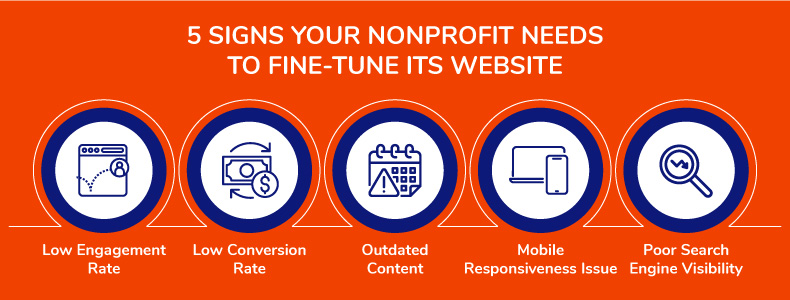5 Signs Your Nonprofit Needs To Fine-Tune Its Website

For many nonprofits, website development is a top priority immediately following their organization’s inception. Your nonprofit’s website is crucial for explaining your organization’s work, gathering support, and collecting donations, so getting it up and running quickly is key.
However, since your website has likely been with your nonprofit since its early stages, there may be opportunities for refinement. Even if your organization or website is fairly new, you can still make small adjustments that lead to far-reaching improvements for your site.
We’ll provide insight into five common problems nonprofits run into with their websites and how you can resolve these issues. That way, you can be confident that your site offers a positive user experience and encourages people to get involved with your mission.

1. Low Engagement Rate
The overall goal of your website should be to provide an engaging experience so that users stay on your site until they find a useful resource or decide to get involved. However, some users will inevitably leave your site immediately after clicking on it.
Engagement rate refers to the percentage of visitors who interact with your website in meaningful ways, such as clicking, completing a form, or viewing multiple pages. If your website has a low engagement rate, then either your content or design likely isn’t engaging or relevant enough to keep users around.
How to Fix This Website Issue
- Alter your content strategy. Perhaps your nonprofit produces blog content once a month. You may consider increasing the frequency to once a week to ensure there are fresh and exciting posts for your supporters to read more often. Additionally, you may make your content more engaging by adding a variety of multimedia elements, such as photos, videos, and infographics.
- Survey your supporters. Not sure which mission-relevant topics your supporters would enjoy learning about? Ask them! Surveying your supporters can unlock key insights into how you can make your content more engaging and informative from those who regularly access your site.
- Improve your website’s navigation. Proper website navigation allows your supporters to easily find what they’re looking for. Ineffective navigation on your site may be causing people to get frustrated and leave quickly, lowering your engagement rate. Highlight your most important pages on a menu at the top of your site, and keep menu titles short for easy readability.
2. Low Conversion Rate
Another metric you can use to measure your website’s success is conversion rate. Conversion rate refers to the percentage of visitors who take an important action on your site that involves them further in your organization.
Whether you’re trying to use your website to convert visitors into donors, volunteers, or event attendees, a low conversion rate means it’s not clear how visitors can get involved, or the process to do so is too complicated. Nonprofit websites have an average conversion rate of 1%, so your goal should be to make small improvements in 0.5% or 1% increments.
How to Fix This Website Issue
- Create strong calls to action. Your calls to action should encourage visitors to get more involved with your cause. NXUnite by Nexus Marketing recommends using concise, urgent language, bold text, and a link to a relevant landing page. For example, you may add a call to action on your homepage that invites visitors to “Donate today!” and directs them to your donation page.
- Simplify your donation process. Facilitate fundraising on your website with a simple donation process. Remove any clutter from your donation page, and ensure your donation form only includes necessary fields, such as name, contact information, donation amount, and payment method. Mark any additional fields or questions as optional.
- Use Google Analytics. Leveraging Google Analytics allows you to stay on top of your website’s conversion rate by creating conversion events and tracking conversions for specific pages. You can also build reports to help you visualize your conversion metrics and easily identify areas for improvement.
3. Outdated Content
If your website has been around for a while, it may contain outdated content. Outdated content may include event pages for past events, old news stories, articles with dated references, or service pages that don’t reflect your current offerings. For example, if you’re no longer recruiting volunteers for a certain project, your volunteer recruitment page may be outdated.
When you leave this content on your site, it can reduce your organization’s credibility and professionalism for visitors. Additionally, it may make your nonprofit appear inactive or disorganized, which can deter potential supporters.
How to Fix This Website Issue
- Conduct a site audit. Start by auditing your site to identify any outdated content. Along the way, you may find other issues such as broken links or duplicate content that your team can resolve.
- Archive old content. Once you’ve identified all outdated content on your site, archive pages that no longer drive value for users. For instance, event pages for past events are a good candidate for archiving because the information is no longer relevant and may distract people from finding your current event content.
- Schedule content refreshes. For outdated content that could still be useful with some fixes, consider scheduling a content refresh. Have your team comb through outdated articles or service pages to remove all incorrect or dated information and replace it with updated content.
4. Mobile Responsiveness Issues
Did you know that 57% of nonprofit website traffic comes from mobile devices? Many people rely on their mobile devices for browsing charitable causes, finding nonprofit events, and donating.
If your website isn’t mobile-friendly, you could lose users right off the bat. Even though the desktop version of your website may look flawless, those accessing your site on mobile may have a negative user experience, causing them to abandon your site.
How to Fix This Website Issue
- Choose the right content management system. Some content management systems (CMS) assist you in configuring a mobile-friendly site. Cornershop Creative recommends using WordPress because it’s compatible with Avada, a website builder with mobile-friendly themes. Additionally, the WP Popup plugin allows you to prevent popups from appearing in mobile view where they can obstruct key information on the page.
- Compress and resize images. While some images may appear large enough on a desktop, they may be too small to see or read properly on a mobile device. Make sure that images are large enough for mobile users, but compress those with large file sizes to increase page load speed.
- Test mobile view. When in doubt, use Google’s Inspect function (right-click and select “inspect” while viewing your web page) or your CMS to test your website’s mobile view. You may find that you need to rearrange the formatting of the text to fit the screen properly or enlarge the font size, which can also make your website more accessible to those who are visually impaired.
5. Poor Search Engine Visibility
It’s difficult to reach potential supporters if your content and website aren’t ranking well on Google and other search engines. Your goal should be for your site to rank as high as possible for searches that are relevant to your cause.
When nonprofit websites have poor search engine visibility, it’s typically due to issues with search engine optimization (SEO) and content quality. To attract interested users, you need to prepare your site for search engines while still creating high-quality, relevant content.
How to Fix This Website Issue
- Choose the right keywords. One of the keys to SEO is choosing keywords that reflect your organization’s content and mission. For example, an animal shelter may target keywords like “donate to animal rescue” for their donation page and “volunteer with animals” for their volunteer page. Then, incorporate these keywords into your site content.
- Prioritize your most important pages. While it would be ideal if as many of your pages as possible rank highly, it’s best to focus on your most important pages first. Many nonprofits prioritize refreshing and optimizing their pages that drive conversions before moving on to educational blog posts and secondary pages.
- Work with an SEO expert. If you’re not sure how to best optimize your website for search engines, work with an SEO expert. In particular, an agency that specializes in nonprofit website design and SEO will be able to tend to your organization’s specific needs and put your mission at the forefront of your site’s SEO strategy.
Don’t fret if you see one or more of these signs indicating that your nonprofit needs to fine-tune its website! That just means you need to put in a little extra time to get your website up to par with current best practices to attract potential supporters and continue promoting your mission. To avoid large website overhauls, revamping your website strategy on a regular basis can help keep your content fresh and your site running smoothly.


